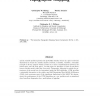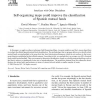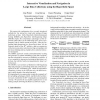92 search results - page 11 / 19 » The Parameter-Less Self-Organizing Map algorithm |
NECO
1998
13 years 9 months ago
1998
Latent variable models represent the probability density of data in a space of several dimensions in terms of a smaller number of latent, or hidden, variables. A familiar example ...
AROBOTS
2008
13 years 9 months ago
2008
This paper presents a novel method for enabling a robot to determine the position of a sound source in three dimensions using just two microphones and interaction with its environm...
EOR
2006
13 years 9 months ago
2006
In this paper, we apply nonlinear techniques (Self-Organizing Maps, k-nearest neighbors and the k-means algorithm) to evaluate the official Spanish mutual funds classification. Th...
JMM2
2008
13 years 9 months ago
2008
Unsupervised or Self-Organized learning algorithms have become very popular for discovery of significant patterns or features in the input data. The three prominent algorithms name...
ICDM
2003
IEEE
14 years 3 months ago
2003
IEEE
We propose the combination of two recently introduced methods for the interactive visual data mining of large collections of data. Both, Hyperbolic Multi-Dimensional Scaling (HMDS...



